Brocket Hall
| Brocket Hall | |
| Hertfordshire | |
|---|---|
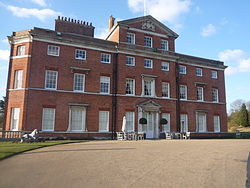 Brocket Hall | |
| Location | |
| Grid reference: | Expression error: Unexpected < operator.&y=Expression error: Unexpected < operator.&z=120 TL2141304 |
| Location: | 51°48’10"N, 0°14’26"W |
| History | |
| Built c. 1760 | |
| For: | Sir Matthew Lamb by Sir James Paine |
| Country house | |
| Neo-classical | |
| Information | |
| Owned by: | Lord Brocket |
| Website: | www.brocket-hall.co.uk |
Brocket Hall is a classical country house set in a large park at the northern end of the urban area of Hatfield in Hertfordshire. The estate is equipped with two golf courses and seven smaller listed buildings, apart from the main house. The house is a Grade I listed building.[1]
The freehold on the estate is held by Baron Brocket. The Club Corporation of Asia (CCA) currently holds the property on a long lease which will only expire in the middle of the 21st century.
Buildings
Sir Matthew Lamb, 1st Baronet, purchased the estate in 1746, complete with Brocket Lea, the older house on the south side of the upper course of the river visible from almost all of the estate.[2] He built the hall as it is seen today around 1760 to the designs of the architect Sir James Paine.
Brocket Hall is a tall red brick neoclassical house in a fine landscape setting with a Palladian bridge. The interior of the house is mostly not on a grand scale but the exceptions are the main staircase and the Grand Saloon that was decorated specifically for entertaining royalty. The walls are lined with silk, the original furniture was made by Thomas Chippendale, the ceiling was painted by Francis Wheatley and the state banqueting table seats eighty people. The cost of this one room is recorded as £1,500 which equated to more than the cost of a substantial mansion at the time.
Paine also built the Temple with an Adam-style plaster ceiling, elliptical porch that has niches either side of Victorian period half glazed door and a pediment above its eastern entrance, typical of the finest garden temples of the era.[3]
Among these other buildings are an early 17th-century house, which now incorporates a fine-dining restaurant called "Auberge du Lac", Brocket Lea and The Temple built by Paine later that century.
Park
The pleasure grounds were laid out initially in the mid-18th century as parkland with many clumps of trees and singles, being remodelled as a pleasure circuit with a waterside walk as part of Woods' campaign of the 1770s.[4]
The park surrounds the hall which is set in open parkland with the remains of scattered parkland trees. The parkland is since the mid-1990s largely overlain by golf courses and is bounded by substantial woodland belts.[4]
History
On the parkland site were two predecessors, the first of which was built in 1239 as Watership or Durantshide manor early held variously of Hatfield Manor and the Bishop of Ely. One of these was built about 1430; whereas in 1413 John Mortimer held Waterships it is known in 1477 Thomas Brockett held both manors.[5] The family continued to occupy both — being in 1553 home to Sir John Brocket, a wealthy spice importer and Captain of Queen Elizabeth’s personal guard. His daughter Mary was the heiress to the estate who married Thomas Reade.
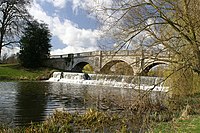
Sir Matthew Lamb's son was Peniston Lamb, 1st Viscount Melbourne and he was often visited at Brocket Hall by the Prince Regent, who had a liaison with Lady Melbourne.
The next owner was William Lamb, 2nd Viscount Melbourne, who was Queen Victoria's first Prime Minister, from 1835–41, and during his ministry the Queen regularly visited. Melbourne's wife, Lady Caroline Lamb, infamously had an affair with Lord Byron causing Lord Melbourne much embarrassment. For one of his birthdays she held a state banquet in the Saloon, at which she had herself served from a large silver dish, naked.[6]
On Lamb's death, the house passed to his sister, Emily, whose second husband was another Prime Minister, Lord Palmerston.
On Emily's death, the hall then passed to Emily's grandson by her first marriage, Francis Cowper, 7th Earl Cowper, though it was his younger brother, Henry (d.1887), who lived at Brocket.
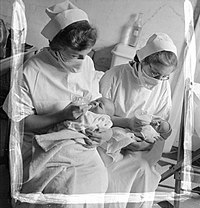
In 1893, Lord Mount Stephen, President of the Bank of Montreal and the first Canadian to be elevated to the Peerage of the United Kingdom, leased Brocket Hall from the 7th Earl for the remainder of his lifetime. For the next three years guests included the Queen's children: the Prince and Princess of Wales, the Duke and Duchess of Connaught and the Princess Mary, Duchess of Teck. In 1897, one year after his first wife died in 1896, Mount Stephen married Georgina Mary (known as Gian) Tufnell, the Lady-in-Waiting to Princess Mary Adelaide, the Duchess of Teck, who encouraged the match. Gian was a lifelong friend and confidant of the Duchess's daughter, Mary of Teck, the wife of King George V, and the Mount Stephenses regularly entertained the royal couple. Gian preferred life at Brocket Hall to the social life that surrounded their London residence at Carlton House Terrace. Lady Mount Stephen was a close friend of Georgina Gascoyne-Cecil, Marchioness of Salisbury, who lived on the neighbouring estate, Hatfield House[7]. She was said to have been exceedingly popular around Hatfield, and her many benefactions endeared her to hundreds.
After the death of the 7th Earl Cowper (1905), the underlying future reversion was left to his niece, but she died only a year after him (1906) and the estate passed to her husband, Admiral Lord Walter Kerr, who lived at Melbourne Hall. When the life tenant Lord Mount Stephen died in 1921, Kerr put the estate up for sale and in 1923 it was purchased by Sir Charles Nall-Cain who co-ran the brewing company Walker Cain Ltd; he was created Baron Brocket in 1933. His son, the 2nd Baron Brocket, Ronald Nall-Cain, was less well regarded: he was a Nazi sympathiser and when he was interned during the Second World War, his property was sequestrated and put to use as a maternity hospital.
Recent uses
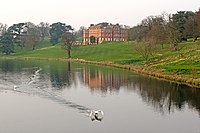
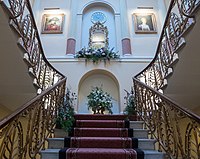
In the late 20th century Charles Nall-Cain, 3rd Baron Brocket (styled (Lord) Charlie Brocket), while serving two and a half years in prison for insurance fraud, let the whole estate for a minimum of 60 years to CCA (Club Corporation of Asia) based in Hong Kong; he has since gone on to present television programmes such as Bad Lads Army and Scream! If You Want to Get Off. The company converted Brocket Hall into a hotel and conference centre and built a second eighteen-hole golf course (Palmerston Course). Further facilities include a Palmerston Golf Academy, and a restaurant called Auberge du Lac which was formerly associated with celebrity chef Jean-Christophe Novelli and once held a Michelin Star.
Within its grounds is an early 17th-century home in red brick, almost facing it across the Broadwater, a landscaped section of the River Lea which forms the central valley of the park.[2]
On film
Brocket Hall has also been used as filming location for a number of large-scale film and television productions, including:
- Night of the Demon (1957)
- Murder with Mirrors
- Johnny English Reborn
- 'The Queen
- Willow and
- Pride and Prejudice (1995 television series) [8]
On television it has also featured in episodes of:
- Inspector Morse (1991)
- Agatha Christie's Poirot (2013)
- Victoria, in scenes set at Brocket in Lord Melbourne's day
- and as wedding locations in EastEnders and Holby City
As a filming location for pop videos, Brocket Hall has hosted Shakin' Stevens ("You Drive Me Crazy", 1980), Steps ("It's The Way You Make Me Feel", 2001.
Outside links
| ("Wikimedia Commons" has material about Brocket Hall) |
References and notes
- References
- ↑ National Heritage List 1100987: Brocket Hall
- ↑ 2.0 2.1 National Heritage List 1100993: Brocket Lea
- ↑ National Heritage List 1100988: (Garden) Temple
- ↑ 4.0 4.1 National Heritage List 1000540: Brocket Hall Park and Garden
- ↑ Parishes: Hatfield – A History of the County of Hertford - Volume 3 : {{{2}}} (Victoria County History)
- ↑ 'Scandalous stately homes': The Telegraph
- ↑ Lady Mount Stephen in Every Woman's Encyclopedia
- ↑ "Johnny English and his links to Hertfordshire - News", Welwyn Hatfield Times, 15 October 2011. Retrieved 19 November 2012.
